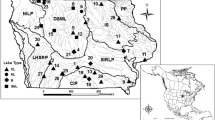Abstract
The National Lake Fish Tissue Study (NLFTS) was the first survey of fish contamination in lakes and reservoirs in the 48 conterminous states based on a probability survey design. This study included the largest set (268) of persistent, bioaccumulative, and toxic (PBT) chemicals ever studied in predator and bottom-dwelling fish species. The U.S. Environmental Protection Agency (USEPA) implemented the study in cooperation with states, tribal nations, and other federal agencies, with field collection occurring at 500 lakes and reservoirs over a four-year period (2000–2003). The sampled lakes and reservoirs were selected using a spatially balanced unequal probability survey design from 270,761 lake objects in USEPA’s River Reach File Version 3 (RF3). The survey design selected 900 lake objects, with a reserve sample of 900, equally distributed across six lake area categories. A total of 1,001 lake objects were evaluated to identify 500 lake objects that met the study’s definition of a lake and could be accessed for sampling. Based on the 1,001 evaluated lakes, it was estimated that a target population of 147,343 (±7% with 95% confidence) lakes and reservoirs met the NLFTS definition of a lake. Of the estimated 147,343 target lakes, 47% were estimated not to be sampleable either due to landowner access denial (35%) or due to physical barriers (12%). It was estimated that a sampled population of 78,664 (±12% with 95% confidence) lakes met the NLFTS lake definition, had either predator or bottom-dwelling fish present, and could be sampled.
Similar content being viewed by others
References
Blick, D. J., Messer, J. J., Landers, D. H., & Overton, W. S. (1987). Statistical basis for the design and interpretation of the national surface water survey, phase I: Lakes and streams. Lake and Reservoir Management, 3, 470–475.
Diaz-Ramos, S., Stevens, D. L., Jr., & Olsen, A. R. (1996). EMAP statistics methods manual. U.S. Environmental Protection Agency, Office of Research and Development, National Health and Environmental Effects Research Laboratory, Corvallis, OR. EPA/620/R-96/002.
Horn, C. R., & Grayman, W. M. (1993). Water-quality modeling with EPA reach file system. Journal of Water Resources Planning and Management, 119, 262–274.
Landers, D. H., Overton, W. S., Linthurst, R. A. & Brakke, D. F. (1988). Eastern lake survey: Regional estimates of lake chemistry. Environmental Science & Technology, 22, 128–135.
Larsen, D. P., & Christie, S. J. (1993). EMAP-Surface waters 1991 pilot report. U.S. Environmental Protection Agency, Office of Research and Development, Environmental Research Laboratory, Corvallis, Oregon. EPA-620-R-93-003.
Larsen, D. P., Thornton, K. W., Urquhart, N. S., & Paulsen, S. G. (1994). The role of sample surveys for monitoring the condition of the Nation’s lakes. Environmental Monitoring and Assessment, 32, 101–134.
Peterson, S. A., Hughes, R. M., Larsen, D. P., Paulsen, S. G., & Omernik, J. M. (1995). Regional lake quality patterns: Their relationship to lake conservation and management decisions. Lake and Reservoirs: Research and Management, 1, 163–168.
Peterson, S. A., Larsen, D. P., Paulsen, S. G., & Urquhart, N. S. (1998). Regional lake trophic patterns in the northeastern United States: Three approaches. Environmental Management, 22, 789–801.
R Development Core Team (2007). The R Project for Statistical Computing. R Development Core Team, Vienna, Austria (website) http://www.R-project.org.
Stahl, L. L., Snyder, B. D., Olsen, A. R., & Pitt, J. L. (2008). Contaminants in fish tissue from U.S. lakes and reservoirs: A national probabilistic study. Environmental Monitoring and Assessment. doi:10.1007/s10661-008-0669-8
Stevens, D. L., Jr., & Olsen, A. R. (1999). Spatially restricted surveys over time for aquatic resources. Journal of Agricultural, Biological, and Environmental Statistics, 4, 415–428.
Stevens, D. L., Jr., & Olsen, A. R. (2003). Variance estimation for spatially balanced samples of environmental resources. Environmetrics, 14, 593–610.
Stevens, D. L., Jr., & Olsen, A. R. (2004). Spatially-balanced sampling of natural resources. Journal of American Statistical Association, 99, 262–278.
Thompson, S. (1992). Sampling. New York, NY: John Wiley and Sons.
U.S. Environmental Protection Agency (USEPA) (1978). National eutrophication survey, working papers 474, 475, 476, 477. Corvallis Environmental Research Laboratory and Las Vegas Environmental Monitoring and Support Laboratory, Washington, DC.
U.S. Environmental Protection Agency (USEPA) (1998). A multimedia strategy for priority persistent, bioaccumulative, and toxic (PBT) Pollutants [Draft]. U.S. EPA, Office of Water, Washington, DC. EPA-823-R-99-014.
U.S. Environmental Protection Agency (USEPA) (1999). National study of chemical residues in lake fish tissue: Study design. U.S. Environmental Protection Agency, Office of Science and Technology, Washington, DC.
U.S. Environmental Protection Agency (USEPA) (2000). Field sampling plan for the National Study of Chemical Residues in Lake Fish Tissue. U.S. EPA, Office of Water, Office of Science and Technology, Washington, DC. EPA-823-R-02-004.
U.S. Environmental Protection Agency (USEPA) (2005a). Quality assurance report for the National Study of Chemical Residues in Lake Fish Tissue: Analytical data for years 1 through 4. U.S. EPA, Office of Water, Washington, DC. EPA-823-R-05-005.
U.S. Environmental Protection Agency (USEPA) (2005b). Quality assurance project plan for data analysis activities for the national study of chemical residues in lake fish tissue. Washington, DC: U.S. Environmental Protection Agency, Office of Water.
U.S. Environmental Protection Agency (USEPA) (2006). Wadeable stream assessment: A collaborative survey of the Nation’s streams. U.S. EPA, Office of Water, Washington, DC. EPA 841-B-06-002.
U.S. Environmental Protection Agency (USEPA) (2007a). National estuary program coastal condition report. U.S. EPA, Office of Water, Washington, DC. EPA-842-B-06-001.
U.S. Environmental Protection Agency (USEPA) (2007b). 2005/2006 National listing of fish advisories fact sheet. U.S. Environmental Protection Agency, Office of Water, Washington, DC. EPA-823-F-07-003.
U.S. Environmental Protection Agency (USEPA) (2007c). Survey of the Nation’s lakes. U.S. EPA (website). http://www.epa.gov/owow/lakes/lakessurvey/.
Yeardley, R. B., Jr, Lazorchak, J. M., Paulsen, S. G. (1998). Elemental fish tissue contamination in northeastern U.S. lakes: Evaluation of an approach to regional assessment. Environmental Toxicology and Chemistry, 17, 1875–1884.
Author information
Authors and Affiliations
Corresponding author
Rights and permissions
About this article
Cite this article
Olsen, A.R., Snyder, B.D., Stahl, L.L. et al. Survey design for lakes and reservoirs in the United States to assess contaminants in fish tissue. Environ Monit Assess 150, 91–100 (2009). https://doi.org/10.1007/s10661-008-0685-8
Received:
Accepted:
Published:
Issue Date:
DOI: https://doi.org/10.1007/s10661-008-0685-8




